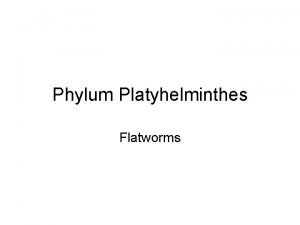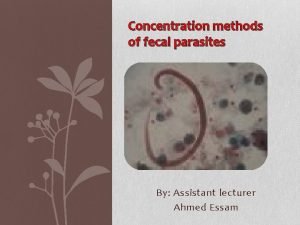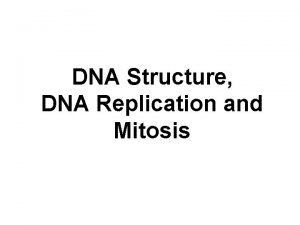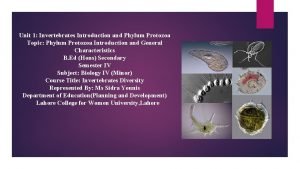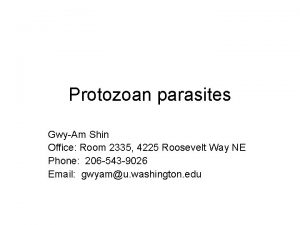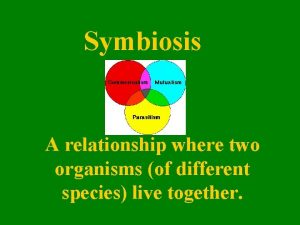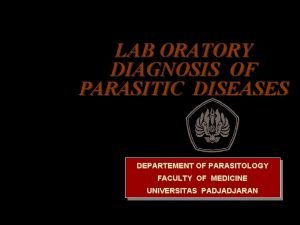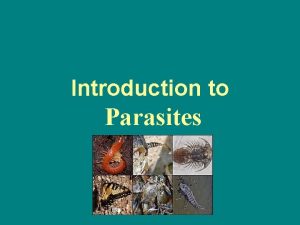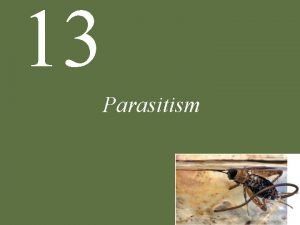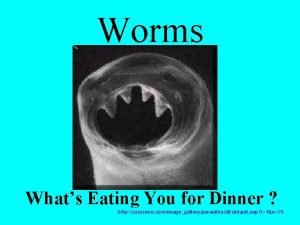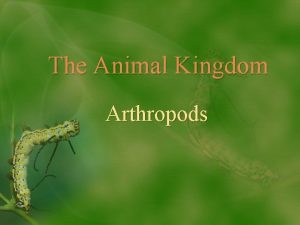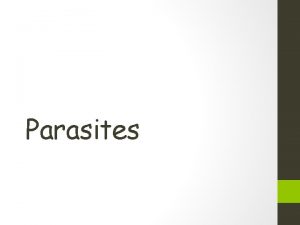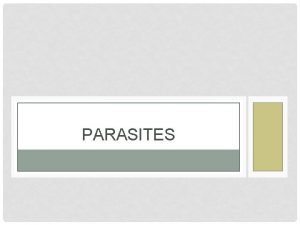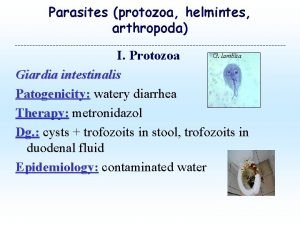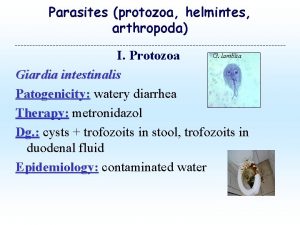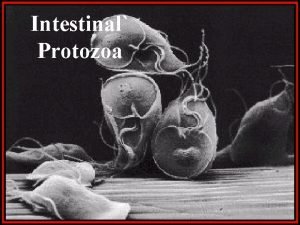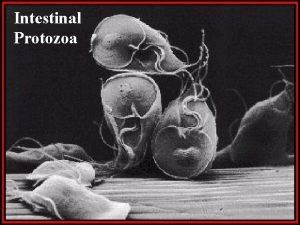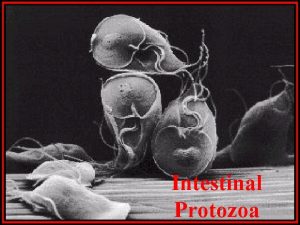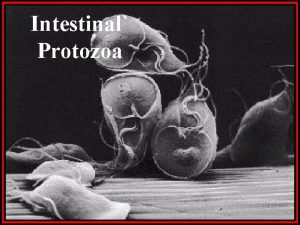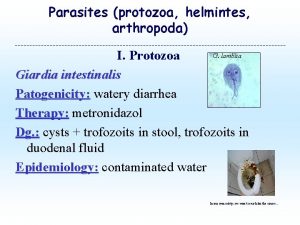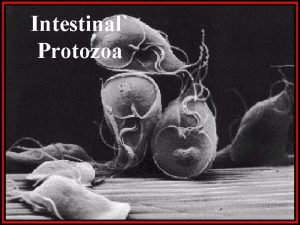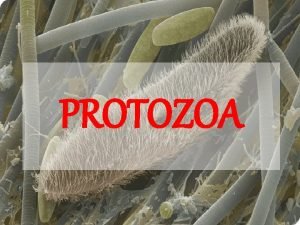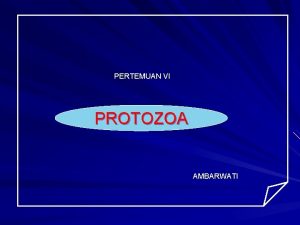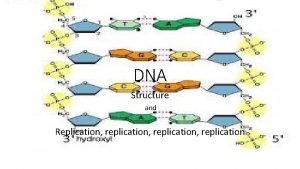STRUCTURE AND REPLICATION OF PARASITES 1 PROTOZOA Protozoa
















- Slides: 16

STRUCTURE AND REPLICATION OF PARASITES

1. PROTOZOA: Protozoa are unicellular organisms that occur singly or in colony formation. Each protozoon is a complete unit capable of performing the physiologic functions that in higher organisms, are carried on by specialized cells. The vital functions of the protozoa are carried out by the protoplasm. The protoplasm is a coarse or fine granular substance. It is differentiated into nucleoplasm and cytoplasm.

The cytoplasm consists of a thin outer ectoplasm. The ectoplasm functions in movement, ingestion of food, excretion, respiration and protection. The organs of locomotion are prolongation of ectoplasm known as pseudopodia, cilia, flagella. Food may be taken in at any place in the cytoplasm.

*The granular endoplasm is concerned with nutrition and reproduction. It may also contain food vacuole, food reserves, contractile vacuole. Contractile vacuole function in regulation of osmotic pressure, and the elimination of waste material. • The nucleus is essential for maintaining and reproducing life. • *The survival of protozoa is largely due to their highly developed reproductive power. Reproduction in the parasitic protozoa may be asexual or sexual. ****

2. NEMATODES (ROUNDWORMS) • The nematode include numerous free-living and parasitic species. The free- living forms are widely distributed in water and soil. The parasitic species live in plants, snails, arthropods & vertebrates. It is estimated that more than 80, 000 species are parasites of vertebrates. v The species parasitic in humans range in length from 2 mm to more than a meter. v The sexes are separate. The male is smaller than the female, having a curved posterior end. ***

v The adult nematodes is an elongated, cylindrical worm. The anterior end may be equipped with hooks, teeth, (plates) for purposes of attachment, abrasion and sensory response. The supporting body wall consist of (i) outer non-cellular cuticle (ii) epithelium (iii) a layer of muscle cells. The cuticle has spines and sensory papillae.

v The body wall surrounds a cavity, within which lie the digestive, reproductive and parts of the nervous and excretory systems. The alimentary tract is a simple tube extending from the mouth to the anus, which opens on the ventral surface. v. There is no circulatory system. The fluid of the body cavity contains hemoglobin, glucose, proteins, salts, and vitamins fulfills functions of blood.

3. THE CESTODA (TAPEWORMS) Tapeworms are parasitic worms. The adults inhabit the intestinal tract of vertebrates and the larvae inhabit the tissues of vertebrates and invertebrates. Adults are elongated, ribbon-like, flattened dorsoventrally. Have no alimentary canal or vascular tracts. They are usually divided into segments (proglottids). Mature proglottids contain both male and female sets of reproductive organs.

The anterior end is modified into an organ of attachment, the scolex, armed with suckers with hooks. The adult tapeworm consists of: (i) A scolex equipped for attachment (ii) A neck, the posterior portion is the region of growth. (iii) The strobila – a chain of progressively developing segments (proglottids). The length of the different species varies from 3 mm to 10 meters, and the number of proglottids from 3 to 4000. Adult tapeworms such as Taenia solium T. saginata have a life span of 20 -25 years.

4. TREMATODA (FLUKES) ¨ Adult trematodes are usually flat, elongated leaf shaped, ovoid, conical, or cylindrical. They vary in size from less than 1 mm to several centimeters. The worm is enveloped by a noncellular integument which is covered with spines or ridges. The integument plays an important role in the absorption of carbohydrate. The worms are attached to the host by cupshaped muscular suckers with spines or hook. ¨ A muscular pharynx extends from the mouth in the oral sucker to a short narrow esophagus.

¨ The adult fluke moves by contraction, elongation, and flexion. It maintains its position in the host by its suckers. ¨ Nutrition is obtained from tissues, secretions or intestinal contents of the host.





 Bioflix activity dna replication lagging strand synthesis
Bioflix activity dna replication lagging strand synthesis Bacteria virus fungi and parasites
Bacteria virus fungi and parasites Internal and external parasites
Internal and external parasites Ova cysts and parasites
Ova cysts and parasites Section 24-1 viral structure and replication
Section 24-1 viral structure and replication Forms of dna
Forms of dna Dna structure and replication packet answer key
Dna structure and replication packet answer key Dna structure and replication
Dna structure and replication Holozoic nutrition
Holozoic nutrition Protozoa diagram
Protozoa diagram What are some mutualism relationships
What are some mutualism relationships Kato katz technique
Kato katz technique Entamoeba histolytica common name
Entamoeba histolytica common name Parasite
Parasite Hookworm vs threadworm
Hookworm vs threadworm Embryo development
Embryo development Parasites alimentaires
Parasites alimentaires


